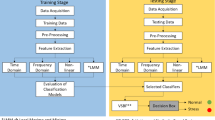Abstract
In this paper, a body sensor network (BSN) based context-aware QRS detection scheme is proposed. The algorithm uses the context information provided by the body sensor network to improve the QRS detection performance by dynamically selecting those leads with the best SNR and taking advantage of the best features of two complementary detection algorithms. The accelerometer data from the BSN are used to classify the daily activities of patients and provide context information. The classification results indicate the types of activities that were engaged in. They also indicate their corresponding intensity, which is related to the signal-to-noise ratio (SNR) of the ECG recordings. Activity intensity is first fed to the lead selector to eliminate those leads with low SNR, and then is fed to a selector to select a proper QRS detector according to the noise level. An MIT-BIH noise stress test database is used to evaluate the algorithms.




Similar content being viewed by others
References
Data from Centers for Disease Control and Prevention (CDC) (1999).
IMIA Yearbook of Medical Informatics 2005: Ubiquitous Health Care Systems (pp. 125–138) (2004).
Anliker, U., Ward, J. A., Lukowicz, P., Troster, G., Dolveck, F., Baer, M., et al. (2004). Amon: A wearable multiparameter medical monitoring and alert system. IEEE Transactions on Information Technology in Biomedicine, 8, 415–427.
Jovanov, E., Milenkovic, A., Otto, C., & de Groen, P. C. (2005). A wireless body area network of intelligent motion sensors for computer assisted physical rehabilitation. Journal of NeuroEngineering and Rehabilitation, 2, 6.
Hill, J., & Culler, D. (2002). Mica: A wireless platform for deeply embedded networks. IEEE Micro, 22, 12–24.
Gao, T., Greenspan, D., Welsh, M., Juang, R. R., & Alm, A. (2005). Vital signs monitoring and patient tracking over a wireless network. In Proceedings of the 27th IEEE EMBS annual international conference.
Wei, Y., Heidemannvand, J., & Estrin, D. (2002). An energy-efficient mac protocol for wireless sensor networks. In Proceedings of the IEEE Infocom (pp. 1567–1576).
van Dam, T., & Langendoen, K. (2003). An adaptive energy-efficient mac protocol for wireless sensor networks. In Proceedings of the 1st ACM conf. on embedded networked sensor systems (Sen-Sys) (pp. 171–180).
Li, H., & Tan, J. (2005). An ultra-low-power medium access control protocol for body sensor network. In Proceedings of the 27th IEEE EMBS annual international conference (pp. 2451–2454).
Karantonis, D. M., Narayanan, M. R., Mathie, M., Lovell, N. H., & Celler, B. G. (2006). Implementation of a real-time human movement classifier using a triaxial accelerometer for ambulatory monitoring. IEEE Transactions on Information Technology in Biomedicine, 10(1), 156–167.
Parkka, J., Ermes, M., Korpipaa, P., Mantyjarvi, J., Peltola, J., & Korhonen, I. (2006). Activity classification using realistic data from wearable sensors. IEEE Transactions on Information Technology in Biomedicine, 10(1), 119–128.
Peter, F., Cohn, K., & Fox, M. (2003). Silent myocardial ischemia. Circulation, 108, 1263.
Berman, D. S., Rozanski, A., & Knoebel, S. B. (1987). The detection of silent ischemia: Cautions and precautions. Circulation, 75(1), 101–105.
Marcus, R., Lowe, R. r., Froelicher, V. F., & Do, D. (1987). The exercise test as gatekeeper. limiting access or appropriately directing resources? Chest, 107, 1442–1446.
Cole, C. R., Blackstone, E. H., Pashkow, F. J., Snader, C. E., & Lauer, M. S. (1999). Heart-rate recovery immediately after exercise as a predictor of mortality. The New England Journal of Medicine, 341, 351–357.
Vivekananthan, D. P., Blackstone, E. H., Pothier, C. E., & Lauer, M. S. (2003). Heart rate recovery after exercise is a predictor of mortality, independent of the angiographic severity of coronary disease. Journal of the American College of Cardiology, 42, 831–838.
Makikallio, T. H., Huikuri, H. V., Makikallio, A., Sourander, L. B., Mitrani, R. D., Castellanos, A., et al. (2001). Prediction of sudden cardiac death by fractal analysis of heart rate variability in elderly subjects. Journal of the American College of Cardiology, 37, 1395–1402.
IEEE 802.15.4, Wireless Medium Access Control (MAC) and Physical Layer (PHY) Specifications for Low-Rate Wireless Personal Area Networks (LR-WPANs), IEEE, 1 October 2003.
Friesen, G., Jannett, T., Jadallan, M., Yates, S., Quint, S., & Nagle, H. (1990). A comparison of the noise sensitivity of nine qrs detection algorithms. IEEE Transactions on Biomedical Engineering, 37, 85–98.
Portet, F., Hernandez, A. I., & Carrault, G. (2005). Evaluation of real-time qrs detection algorithms in variable contexts. Medical & Biological Engineering, 43, 379–385.
Engelse, W. A. H., & Zeelenberg, C. (1979). A single scan algorithm for qrs-detection and feature extraction. Computers in Cardiology, 6, 37–42.
Zong, W., Moody, G. B., & Jiang, D. (2003). A robust open-source algorithm to detect onset and duration of qrs complexes. Computers in Cardiology, 30, 737–740.
Mark, R., & Moody, G. (1988). Mit-bih arrhythmia data base directory. Massachusetts Institute of Technology.
Goldberger, A. L., Amaral, L. A. N., Glass, L., Hausdorff, J. M., Ivanov, P. C., Mark, R. G., et al. (2000). Physiobank, physiotoolkit, and physionet: Components of a new research resource for complex physiologic signals. Circulation, 101, e215–e220.
Acknowledgements
This paper is supported in part by the Chinese 863 plan under key project on core technologies for modular robots, project #2009AA043901, the National Science Foundation under Grant ECS #0528967 and CSR #0720781.
Author information
Authors and Affiliations
Corresponding author
Rights and permissions
About this article
Cite this article
Wei, H., Li, H. & Tan, J. Body Sensor Network Based Context-Aware QRS Detection. J Sign Process Syst 67, 93–103 (2012). https://doi.org/10.1007/s11265-010-0507-4
Received:
Revised:
Accepted:
Published:
Issue Date:
DOI: https://doi.org/10.1007/s11265-010-0507-4




